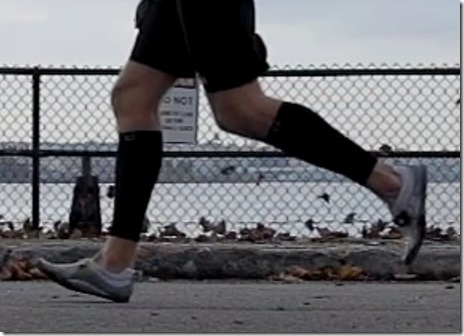Last weekend saw the second annual running of the New York City Barefoot Run. As you can imagine, this brought barefoot running enthusiasts together from across the US and further.
Pete Larson, running aficionado and owner of the popular website runblogger.com, had the great idea of taking his high speed video camera along to observe the technique of the barefoot runners partaking in the race.
Barefoot running and the move individuals make to “barefoot style” running shoes has been hailed by many in recent years as the answer to improving running technique. The suggestion is that by taking your shoes off and running, or running in “barefoot style” shoes such as Vibram Five Fingers, you will automatically land more efficiently on your midfoot rather than on the heel.
Stills from the footage that Pete collected suggest otherwise:


This may come as a bit of a surprise to many who believe all you read in the running media. The message has been presented as being fairly black and white in saying that barefoot running or “barefoot style” running shoes “will automatically stop you from heel striking”.
It’s clear though that there is much more to it in practice!
We also see this regularly with the runners and triathletes we see when coaching on a 1:1 basis.
Another great example of this is the vast number of triathletes we meet for video analysis wearing Newtons, expecting that the shoe alone will make them run on their midfoot. Newton themselves acknowledge that it’s important to work on technique if you plan to use their shoes. However we still see numerous runners wearing Newtons and landing with a pronounced heel strike. As per the video below:
So where am I going with this?
As anybody who we have worked with will know; foot position (heel strike vs midfoot) has almost nothing to do with the foot itself…. no matter what footwear you are (or are not) using!
Let me explain:
As I like to put it… “Foot position as it strikes the ground is only an expression, or end result, of what is going on above… the swing leg mechanics, overall posture and cadence, to name a few important factors”
So no matter what shoe you put on your foot (or leave off your foot), if your technique and posture is poor, you may well still be running heavily and inefficiently.
It’s true to say that a minimalist or “barefoot style” shoe definitely makes it easier to transition from a heel striker to a midfoot runner, but it will not always do the job for you… If only life was that simple!
We work with a number of elite endurance athletes including professional triathletes. Even these guys are often under the impression that they’re midfoot striking when in fact with video analysis it’s evident that they are still heel striking, even in their minimalist racing flats.
When we show them how to actually change their technique to allow them to truly midfoot strike, they normally report minutes dropping off their 10k and 1/2 Marathon times almost automatically!
Is a midfoot / forefoot running style most appropriate for all runners? No. Everybody is different, both in terms of relative strengths and weaknesses, injury history and goals. I explain what I mean by this in my article on Forefoot Running for Ironman Athletes.
How does this affect our technique coaching?
We find that focusing on running cadence (stride frequency), improving the engagement of key muscle groups, and removing imbalances to achieve good running posture enables the runner to improve efficiency within their existing running form – usually resulting in appropriate changes in foot strike.
If you focus on foot strike as the main area of conscious technique change – while ignoring the other important factors, you’ll never reach your potential efficiency.
Last updated on March 2nd, 2021.




Have you heard the term ” proprioceptive heel strike”? Went on a course and a few in our group ( myself included) fit into that category. Watching my form and cadence more closely, this 26 year habit is hard to break!
Hey Dawn,
Thanks for taking the time to comment. Yes indeed, I often refer to a ‘glancing heel strike’ and what I mean by that is also referred to as a ‘proprioceptive heel strike’.
Essentially, this pattern is characterised by a runner contacting the ground with the rearfoot (heel) first, but loading at maximal rate over the midfoot. Typically heel striking runners would load at the greatest rate as the rearfoot strikes the ground. Described further in my post here: http://www.kinetic-revolution.com/dont-believe-the-heel-strike-hype/
Thanks,
James